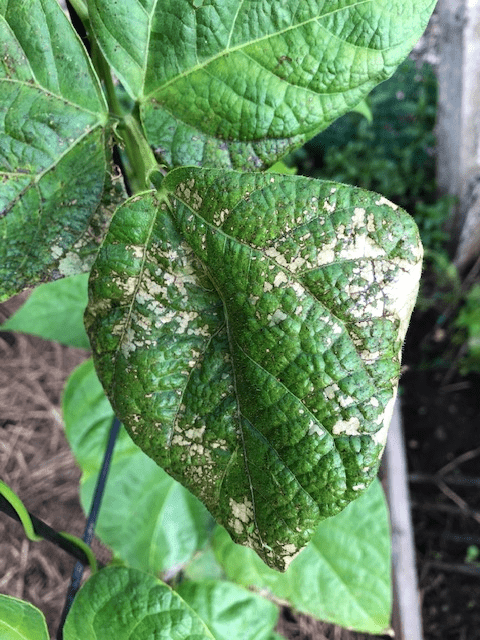Excessive fertilizer
Damage from excessive fertilizer application generally appears as browning of leaf edges or leaf scorch. Soluble salts from fertilizers can pull moisture out of root tissues and cause wilting, marginal yellowing, and stunting. Leaf burn or scorch can also result from direct foliar contact with some fertilizers- granular or liquid. Factors such as soil type, irrigation practices, salt levels, and the sensitivity of specific plants can influence the amount of damage.
Damage to vegetable plants from excess fertilizer is more severe in hot dry weather. Fertilizer salts are more concentrated in the soil under droughty conditions. This can lead to direct root injury, which will show up as leaf scorch. Also, soluble salts may follow water movement through the plant and become concentrated in the leaves where moisture is lost rapidly on hot, dry days through transpiration or evaporation. In cool, cloudy weather, when there is adequate soil moisture, the rate of moisture loss from the leaves is slower, which allows many plants to tolerate high salt levels in the spring months, but not during the summer months.
You can prevent fertilizer burn problems by selecting slow-release organic fertilizers, or incorporating 1-2 inches of compost into the soil each year. Sweep granular fertilizers off foliage, use soluble foliar fertilizers according to label directions, and, if using granular fertilizers, be sure to apply water immediately afterward.
Pesticide burn

Pesticide burn, or phytotoxicity, is caused by misuse or misapplication of chemicals on plants. Symptoms included leaf spots, blotches, scorch, or tip burn. Symptoms are sometimes confused with disease, insect or mite damage, or problems caused by environmental conditions.
Pesticide burn may also occur when pesticides are sprayed on stressed plants. Stressors, such as drought, disease, insect injury, and frost damage, predispose plants to chemical damage. Even non-toxic sprays, such as insecticidal soaps and horticultural oils can result in pesticide burn when sprayed on injured or sensitive plants- especially when the weather is hot, humid, and overcast (poor drying conditions).
Phytotoxicity frequently occurs when pesticides are sprayed under adverse weather conditions. High temperatures and humidity, in general, will increase the possibility of injury from pesticides (insecticides and fungicides; especially soaps, oils, and sulfur compounds). Cool damp weather may increase the chance of injury by copper fungicides. Phytotoxicity may also result when incompatible chemicals are applied at the same time. Damage may also occur due to wind drift onto nontarget or sensitive plants. Spray applications should be applied during calm, dry, and cool conditions. Most pesticides are best applied below 85 F.
If pesticide use is warranted, be sure to apply chemicals according to label directions. Always check label directions for cautions regarding sensitive plants and combining pesticides. The plant you wish to spray should be listed on the label of the pesticide. When insects or diseases seriously damage vegetable plants, sometimes it is best to cut off the damaged parts or re-plant and learn how to prevent the problem next time.